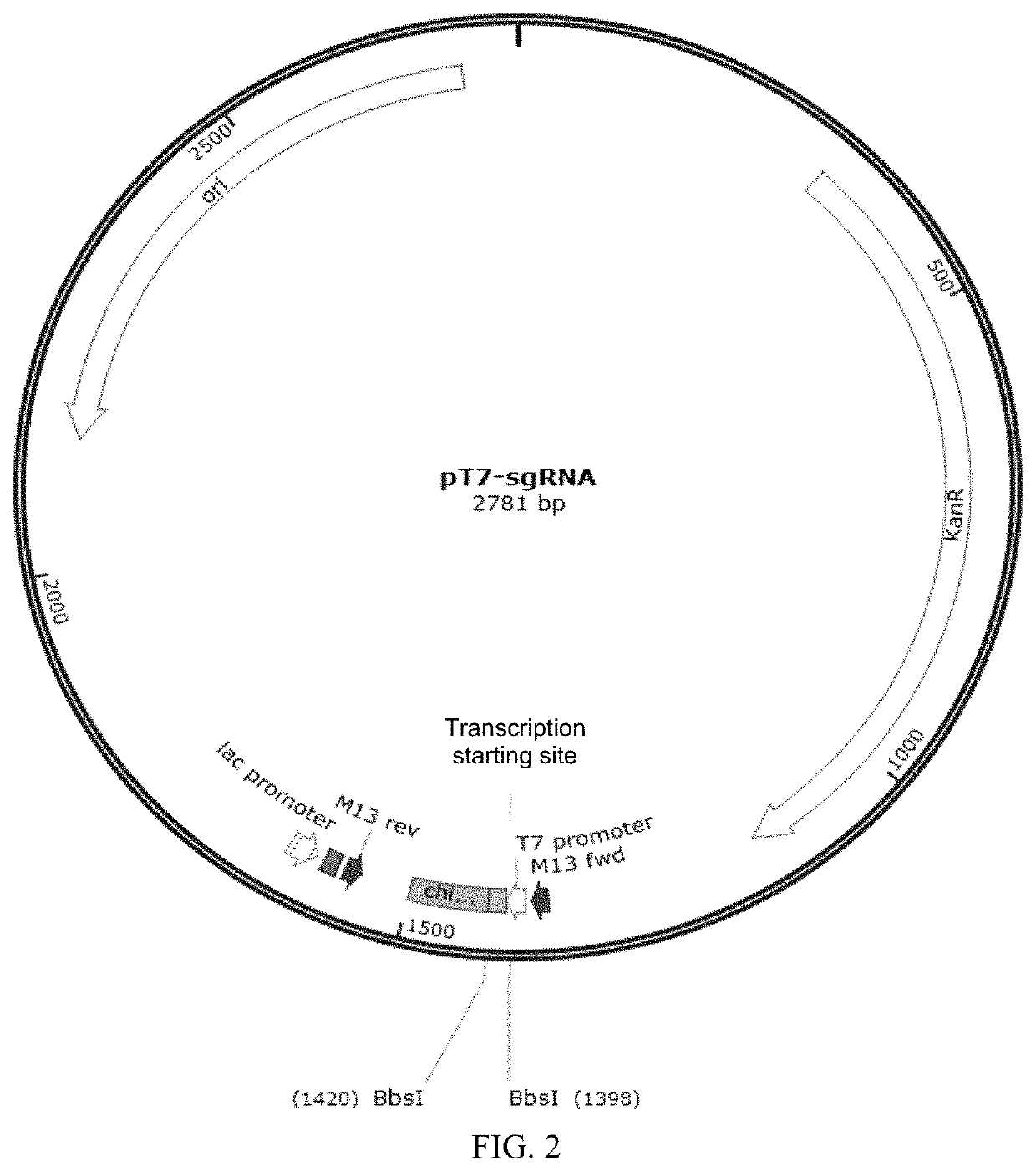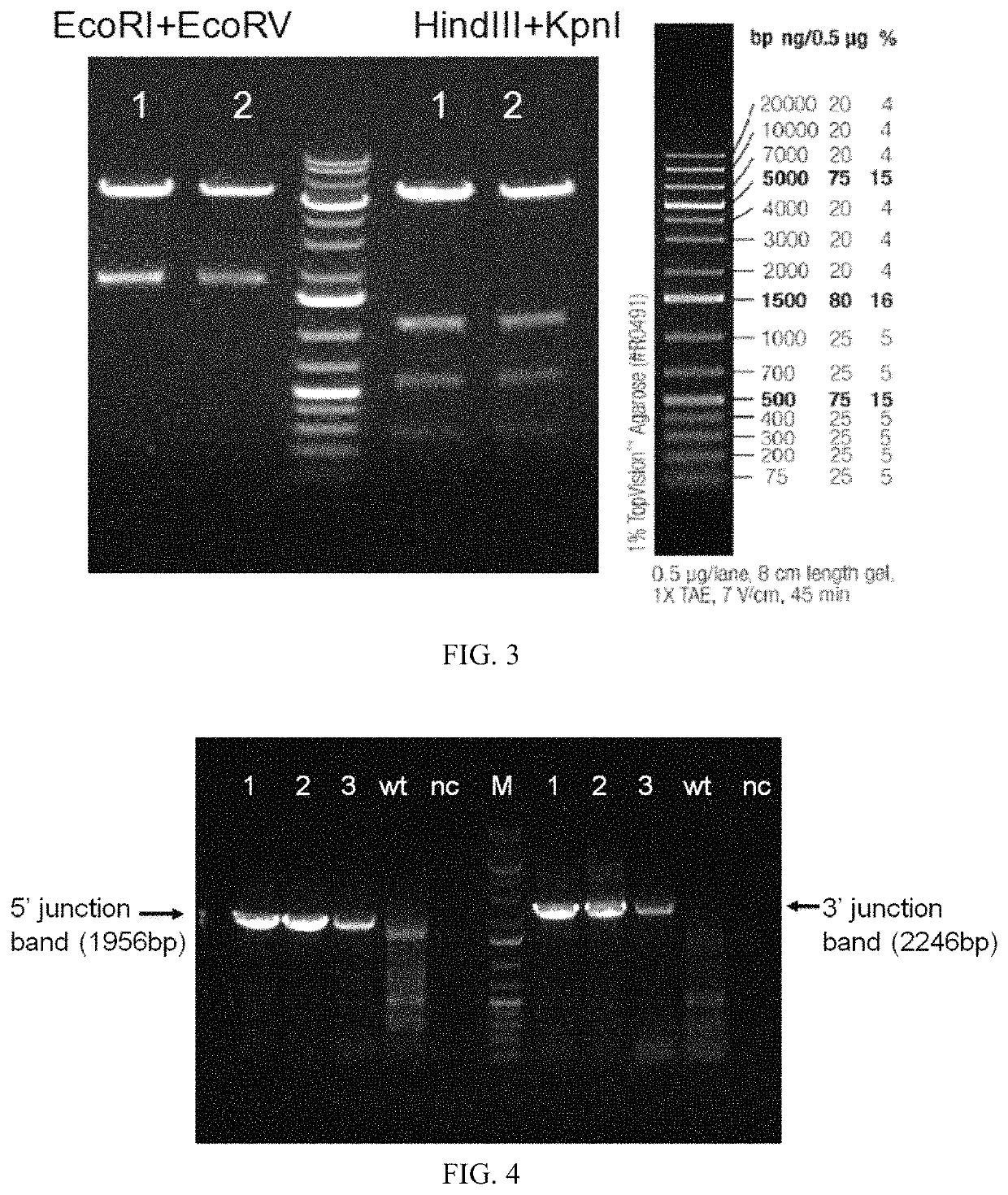Genetically modified mice expressing humanized PD-1
a technology of pd1 and mouse, which is applied in the field of building a humanized pd1 animal model, can solve the problems of difficult to avoid dosage adjustment, and the results obtained from animal models sometimes are not applicable to humans, so as to avoid abnormal mouse expression and minimize the impact of humanization
- Summary
- Abstract
- Description
- Claims
- Application Information
AI Technical Summary
Benefits of technology
Problems solved by technology
Method used
Image
Examples
example 1
Design of sgRNAs Targeting PD-1 Gene
[0089]The target sequence determines the targeting specificity of small guide RNA (sgRNA) and the efficiency of Cas9 cleavage at the target gene. Therefore, target sequence selection was important for sgRNA vector construction.
[0090]Design and synthesize a guide RNA sequence for identifying the 5′-terminal targeting site (sgRNA1 to sgRNA4) and the 3′-terminal targeting site (sgRNA5 to sgRNA8). Using mice as an example, according to the function and sequence features of the PD-1 gene, the 5′-terminal targeting site and the 3′-terminal targeting site were both on the second exon of the mouse PD-1 gene, and the target site sequence of each sgRNA on PD-1 was as follows:
[0091]
sgRNA-1 target site sequence (SEQ ID NO: 1):5′-agggacctccagggcccattggg-3′sgRNA-2 target site sequence (SEQ ID NO: 2):5′-cagaggtccccaatgggccctgg-3′sgRNA-3 target site sequence (SEQ ID NO: 3):5′-gtagaaggtgagggacctccagg-3′sgRNA-4 target site sequence (SEQ ID NO: 4):5′-ccctcaccttctacc...
example 2
Screening of sgRNAs
[0092]The UCA kit was used to detect activities of a plurality of guide sgRNAs screened from Example 1, and it can be seen from the results that the guide sgRNAs have different activities. See FIG. 1 for the detection results.
[0093]Two of them, sgRNA3 and sgRNA8, were selected therefrom for subsequent experiments.
[0094]Upstream and downstream single strands of the sgRNAs were synthesized. See Table 1:
[0095]
TABLE 1List of sgRNA3 and sgRNA8 sequencessgRNA3 sequenceSEQ ID NO: 9Upstream:5′-tagaaggtgagggacctcc-3′SEQ ID NO: 10Downstream:5′-ggaggtccctcaccttcta-3′sgRNA8 sequenceSEQ ID NO: 11Upstream:5′-caaaaatcgaggagagccc-3′SEQ ID NO: 12Downstream:5′-gggctctcctcgatttttg-3′
example 3
Construction of pT7-sgRNA Plasmid
[0096]The source of pT7-sgRNA plasmids: see FIG. 2 for the pT7-sgRNA vector map. The plasmid backbone was from Takara with the Catalog No. 3299. DNA fragments containing a T7 promoter (taatacgactcactatagg) and sgRNA scaffold were synthesized by a plasmid synthesis company (see SEQ ID NO: 13) and were connected to the skeleton vector through enzyme digestion (EcoRI and BamHI). As verified through sequencing by a professional sequencing company, the results show that the target plasmids were obtained.
PUM
 Login to view more
Login to view more Abstract
Description
Claims
Application Information
 Login to view more
Login to view more - R&D Engineer
- R&D Manager
- IP Professional
- Industry Leading Data Capabilities
- Powerful AI technology
- Patent DNA Extraction
Browse by: Latest US Patents, China's latest patents, Technical Efficacy Thesaurus, Application Domain, Technology Topic.
© 2024 PatSnap. All rights reserved.Legal|Privacy policy|Modern Slavery Act Transparency Statement|Sitemap



